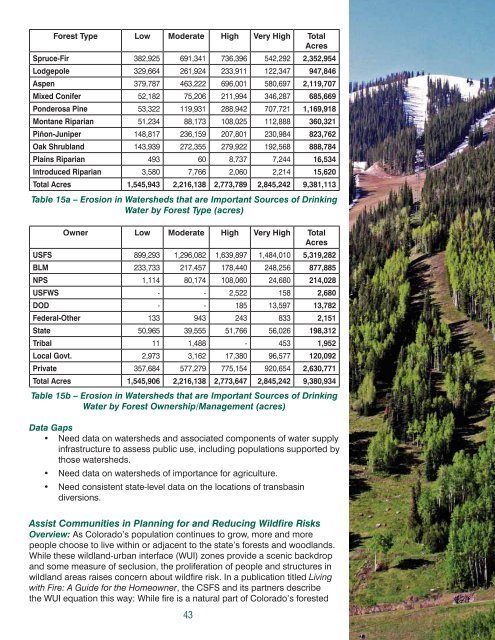Colorado Statewide Forest Resource Assessment
Colorado Statewide Forest Resource Assessment
Colorado Statewide Forest Resource Assessment
You also want an ePaper? Increase the reach of your titles
YUMPU automatically turns print PDFs into web optimized ePapers that Google loves.
<strong>Forest</strong> Type Low Moderate High Very High TotalAcresSpruce-Fir 382,925 691,341 736,396 542,292 2,352,954Lodgepole 329,664 261,924 233,911 122,347 947,846Aspen 379,787 463,222 696,001 580,697 2,119,707Mixed Conifer 52,182 75,206 211,994 346,287 685,669Ponderosa Pine 53,322 119,931 288,942 707,721 1,169,918Montane Riparian 51,234 88,173 108,025 112,888 360,321Piñon-Juniper 148,817 236,159 207,801 230,984 823,762Oak Shrubland 143,939 272,355 279,922 192,568 888,784Plains Riparian 493 60 8,737 7,244 16,534Introduced Riparian 3,580 7,766 2,060 2,214 15,620Total Acres 1,545,943 2,216,138 2,773,789 2,845,242 9,381,113Table 15a – Erosion in Watersheds that are Important Sources of DrinkingWater by <strong>Forest</strong> Type (acres)Owner Low Moderate High Very High TotalAcresUSFS 899,293 1,296,082 1,639,897 1,484,010 5,319,282BLM 233,733 217,457 178,440 248,256 877,885NPS 1,114 80,174 108,060 24,680 214,028USFWS - - 2,522 158 2,680DOD - - 185 13,597 13,782Federal-Other 133 943 243 833 2,151State 50,965 39,555 51,766 56,026 198,312Tribal 11 1,488 - 453 1,952Local Govt. 2,973 3,162 17,380 96,577 120,092Private 357,684 577,279 775,154 920,654 2,630,771Total Acres 1,545,906 2,216,138 2,773,647 2,845,242 9,380,934Table 15b – Erosion in Watersheds that are Important Sources of DrinkingWater by <strong>Forest</strong> Ownership/Management (acres)Data Gaps• Need data on watersheds and associated components of water supplyinfrastructure to assess public use, including populations supported bythose watersheds.• Need data on watersheds of importance for agriculture.• Need consistent state-level data on the locations of transbasindiversions.Assist Communities in Planning for and Reducing Wildfire RisksOverview: As <strong>Colorado</strong>’s population continues to grow, more and morepeople choose to live within or adjacent to the state’s forests and woodlands.While these wildland-urban interface (WUI) zones provide a scenic backdropand some measure of seclusion, the proliferation of people and structures inwildland areas raises concern about wildfi re risk. In a publication titled Livingwith Fire: A Guide for the Homeowner, the CSFS and its partners describethe WUI equation this way: While fi re is a natural part of <strong>Colorado</strong>’s forested43
















